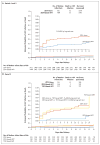Benefits and Risks of Antiretroviral Therapy for Perinatal HIV Prevention
- PMID: 27806243
- PMCID: PMC5214343
- DOI: 10.1056/NEJMoa1511691
Benefits and Risks of Antiretroviral Therapy for Perinatal HIV Prevention
Abstract
Background: Randomized-trial data on the risks and benefits of antiretroviral therapy (ART) as compared with zidovudine and single-dose nevirapine to prevent transmission of the human immunodeficiency virus (HIV) in HIV-infected pregnant women with high CD4 counts are lacking.
Methods: We randomly assigned HIV-infected women at 14 or more weeks of gestation with CD4 counts of at least 350 cells per cubic millimeter to zidovudine and single-dose nevirapine plus a 1-to-2-week postpartum "tail" of tenofovir and emtricitabine (zidovudine alone); zidovudine, lamivudine, and lopinavir-ritonavir (zidovudine-based ART); or tenofovir, emtricitabine, and lopinavir-ritonavir (tenofovir-based ART). The primary outcomes were HIV transmission at 1 week of age in the infant and maternal and infant safety.
Results: The median CD4 count was 530 cells per cubic millimeter among 3490 primarily black African HIV-infected women enrolled at a median of 26 weeks of gestation (interquartile range, 21 to 30). The rate of transmission was significantly lower with ART than with zidovudine alone (0.5% in the combined ART groups vs. 1.8%; difference, -1.3 percentage points; repeated confidence interval, -2.1 to -0.4). However, the rate of maternal grade 2 to 4 adverse events was significantly higher with zidovudine-based ART than with zidovudine alone (21.1% vs. 17.3%, P=0.008), and the rate of grade 2 to 4 abnormal blood chemical values was higher with tenofovir-based ART than with zidovudine alone (2.9% vs. 0.8%, P=0.03). Adverse events did not differ significantly between the ART groups (P>0.99). A birth weight of less than 2500 g was more frequent with zidovudine-based ART than with zidovudine alone (23.0% vs. 12.0%, P<0.001) and was more frequent with tenofovir-based ART than with zidovudine alone (16.9% vs. 8.9%, P=0.004); preterm delivery before 37 weeks was more frequent with zidovudine-based ART than with zidovudine alone (20.5% vs. 13.1%, P<0.001). Tenofovir-based ART was associated with higher rates than zidovudine-based ART of very preterm delivery before 34 weeks (6.0% vs. 2.6%, P=0.04) and early infant death (4.4% vs. 0.6%, P=0.001), but there were no significant differences between tenofovir-based ART and zidovudine alone (P=0.10 and P=0.43). The rate of HIV-free survival was highest among infants whose mothers received zidovudine-based ART.
Conclusions: Antenatal ART resulted in significantly lower rates of early HIV transmission than zidovudine alone but a higher risk of adverse maternal and neonatal outcomes. (Funded by the National Institutes of Health; PROMISE ClinicalTrials.gov numbers, NCT01061151 and NCT01253538 .).
Figures


Comment in
-
Antiretroviral Therapy for Perinatal HIV Prevention.N Engl J Med. 2017 Feb 16;376(7):699. doi: 10.1056/NEJMc1616287. N Engl J Med. 2017. PMID: 28207205 No abstract available.
-
Triple-drug antiretroviral therapy results in lower HIV maternal-fetal transmission rates but increased adverse effects compared with zidovudine alone.J Pediatr. 2017 Mar;182:401-404. doi: 10.1016/j.jpeds.2016.12.068. J Pediatr. 2017. PMID: 28237453 No abstract available.
References
-
- Connor EM, Sperling RS, Gelber R, et al. Reduction of maternal–infant transmission of human immunodeficiency virus type 1 with zidovudine treatment. N Engl J Med. 1994;331:1173–80. - PubMed
-
- Panel on Treatment of HIV-Infected Pregnant Women and Prevention of Perinatal Transmission. Recommendations for use of antiretroviral drugs in pregnant HIV-1-infected women for maternal health and interventions to reduce perinatal HIV transmission in the United States. Rockville, MD: AIDSinfo; 2016. ( http://aidsinfo.nih.gov/contentfiles/lvguidelines/PerinatalGL.pdf)
-
- Mofenson LM. Antiretroviral therapy and adverse pregnancy outcome: the elephant in the room? J Infect Dis. 2016;213:1051–4. - PubMed
-
- Li N, Sando MM, Spiegelman D, et al. Antiretroviral therapy in relation to birth outcomes among HIV-infected women: a cohort study. J Infect Dis. 2016;213:1057–64. - PubMed
Publication types
MeSH terms
Substances
Associated data
Grants and funding
LinkOut - more resources
Full Text Sources
Other Literature Sources
Medical
Research Materials
